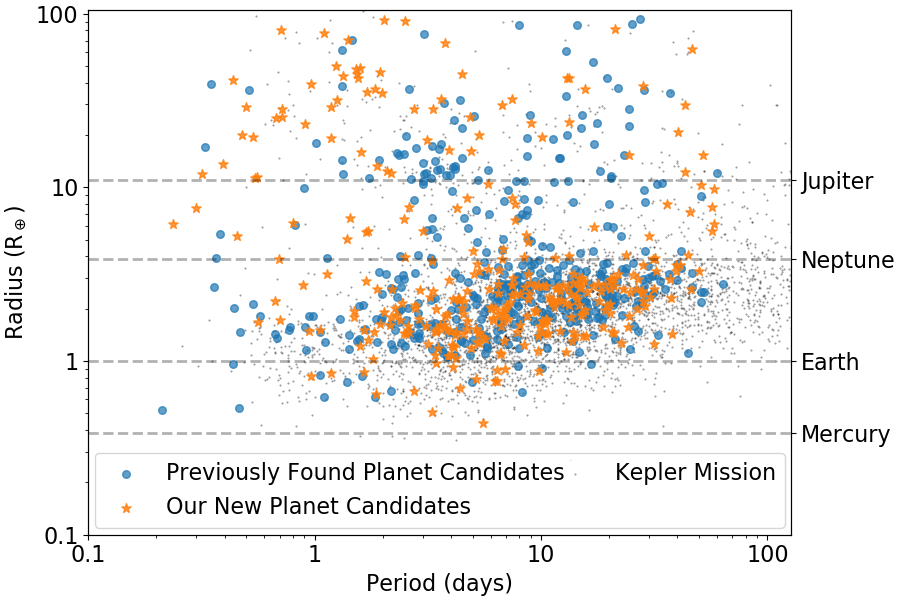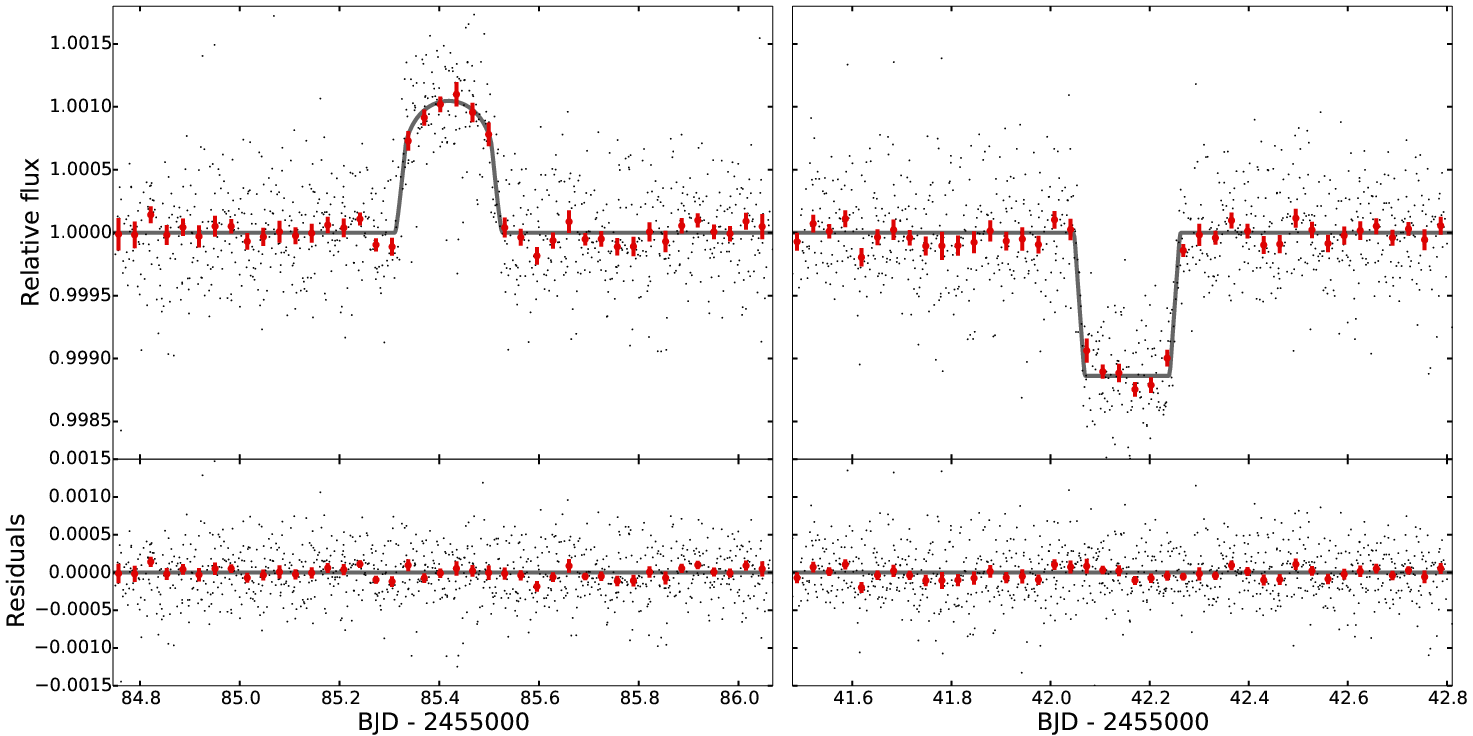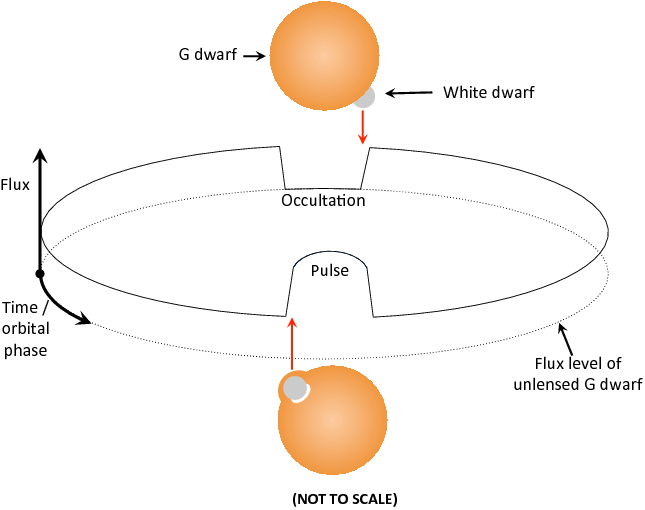Explaining Past Publications
This page is meant to be a very brief review of my
past papers for both astronomers and non-scientists alike.
If you're an astronomer who wants to get the main points
out of a paper but can't be bothered to open the pdf and
skim our discussion and conclusions sections, I have a
TL;DR version for you.
Meanwhile, if you're not an astronomer or scientist and
want to get the point without all the jargon, I've tried to
make simplified ELI5 sections for you.
This is an experiment, so please let me know if this
page was any help to you (and why) or if you think it can be
improved somehow! I do think everyone should make an effort
to explain their scientific results in a more accessible
form alongside their official peer-reviewed papers; this is
my first attempt.
Detection of Hundreds of New Planet Candidates and Eclipsing Binaries in K2 Campaigns 0–8
E. Kruse et al., Astrophysical Journal Supplement Series 244, 11 (2019).
View the published version and
free arXiv version.
For astronomers (TL;DR)
▸

This paper made up the bulk of my PhD thesis. In it, I significantly revamped the
Quasi-periodic Automated Transit Search (QATS) to make it significantly more sensitive to
both regular periodic planets as well as TTV systems. I also made an initial attempt to
simultaneously detect single transit events.
Our first application of our new QATS planet search was on the first 9 K2 campaigns, all
of which had previously been thoroughly searched by at least 3 groups. Nevertheless, we found
over 350 new planet candidates in these K2 campaigns, as shown in the figure.
Some of the highlights of the candidates: a six-planet system, two five-planet systems, a planet with
extreme TTVs, and multiple single-transit planet candidate events. We also found an outer third planet candidate in the
K2-83 system that has a size on the border between rocky and gaseous and is in the habitable zone.
For non-astronomers (ELI5)
▸

This paper made up the bulk of my PhD thesis. In it, I developed a new search technique to find
transiting planets. I applied my search to 150,000 stars observed by Kepler for 80 days each in its
K2 mission.
All of these stars had already been searched using more traditional transit searches by at least
3 other groups. However, all our improvements meant that we were able to find about twice
as many planets as all the other groups combined had found, as can be seen in the figure. In total,
our new search allowed us to discover over 350 new planet candidates.
KOI-3278: A Self-Lensing Binary Star System
E. Kruse and E. Agol, Science 344, 275 (2014).
Free unrestricted reprint
and published full text
courtesy of Science as well as the
arXiv version.
For an animation of the microlensing pulses, see this
video made by Eric Agol.
For astronomers (TL;DR)
▸

This was the discovery of the first ever periodic
microlensing signal. A WD and main sequence G star are in an
eclipsing 88 day orbit. The Kepler pipeline detected the
white dwarf's occultation as a KOI. Roughly half a period
later though, I discovered pulses instead of primary
eclipses — the G star gets brighter as the WD passes
in front and lenses the light, looking identical to an
upside-down planet transit (Figure of pulses and
occultations on right). This type of self-lensing binary
system was first predicted in 1973, but never observed until
now.
We used an MCMC analysis and stellar models to constrain
the mass of the WD to be ~63% solar. The system is likely
around 1.6 Gyr and the primary is very similar to the
Sun.
Because we have periodic eclipses AND pulses, with
followup spectra we will be able to measure very accurate
masses and radii for both stars, which will particularly
help constrain the WD equations of state and the mass-radius
relationship. Future discoveries of similar self-lensing
systems with neutron stars may also be a great way to test
NS mass-radius relationships.
Finally, this system must have gone through a common
envelope phase when the WD formed. This is the longest
period post-common envelope eclipsing binary found to date
(by a factor of 10!). As such, it's going to help constrain
binary evolution models.
For non-astronomers (ELI5)
▸

More than 40% of stars are in pairs that orbit around
each other, called binary star systems. If those orbits are
aligned just right, here on Earth we briefly see the binary
system get dimmer once every orbital period when one star
passes directly in front of the other, blocking some light
and causing an eclipse. This periodic blocking of light
every orbit is how we know a star has a companion —
either a planet or smaller, dimmer star. In this paper
though, we announced the discovery of the first binary
system that gets brighter when one star passes in front of
the other. This is the equivalent of something crossing in
front of the sun, but instead of casting a shadow, the sun
gets brighter!
This strange effect is caused by Einstein's general
relativity. When smaller stars die, they leave behind only
their core (called a white dwarf, WD) — something
around the mass of the Sun but the size of the Earth.
Einstein's theory of general relativity says a WD's strong
gravity will bend light around it, essentially acting like
an Earth-sized magnifying glass. When a WD is in a
binary system and magnifies its companion's light it is
called a self-lensing binary star system, hence the title of
this paper. Here on Earth then, once every orbital period as
the WD passes between us and its companion we would see the
binary system pulse – get briefly brighter
instead of dimmer like a normal eclipse.
To get a pulse instead of an eclipse, the alignment and
orbit has to be very unique. Astronomers first predicted
such self-lensing binary systems should exist back in 1973,
but in this 2014 paper we announced the first ever discovery
of one. This is incredibly cool in its own right, but also
scientifically valuable. The magnification combined with the
dimming half an orbit later (when the WD goes behind the
other star, see the Figure) will provide accurate measures
of the mass and radius of the WD, which is usually much
harder to determine if you don't see the magnification
effect. Like the first planet, this first self-lensing
binary discovery is just the tip of the iceberg. As other
groups start to discover more of these, we'll collect
precise masses and radii of many WDs and can test our models
of particle physics in ways that even the best
supercolliders on Earth can't approach.
In addition, even though most stars are in binary
systems, we have many open questions about how they form and
evolve. This system is the longest period eclipsing binary
with a WD found to date (88 days), which will allow us to
start to answer some of those questions.



